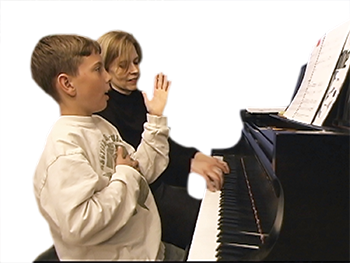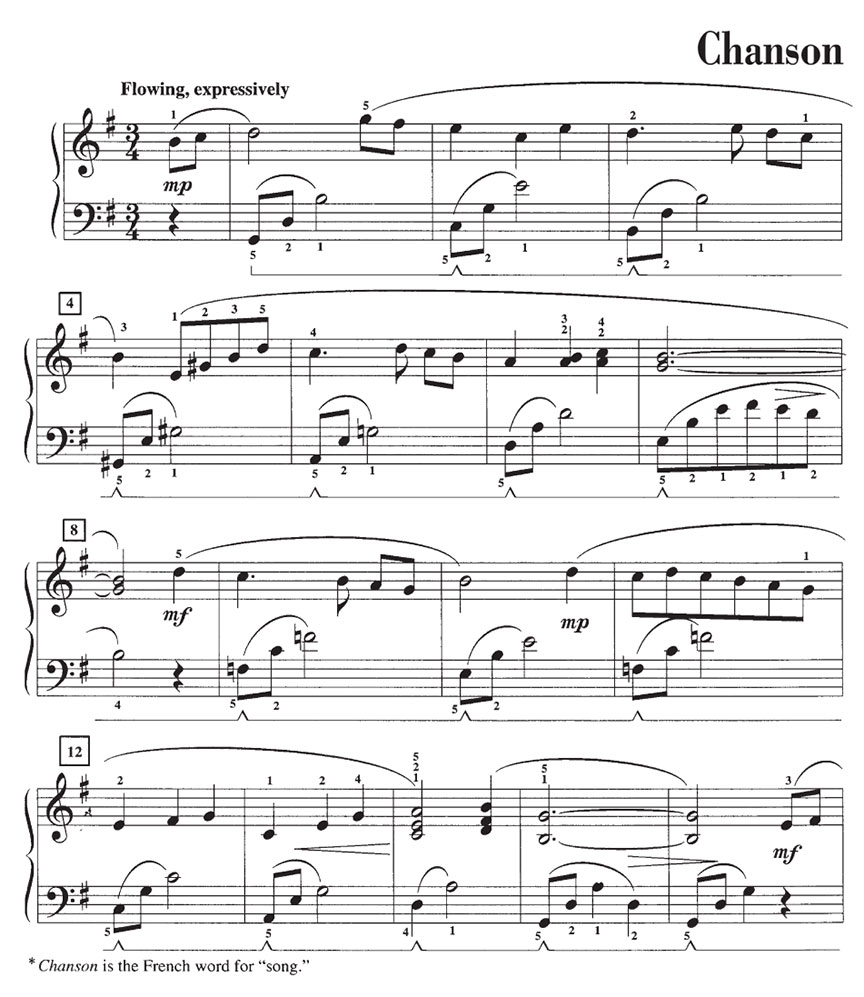Level 4: Lyric Playing and “Personal Sound”
At Level 3B, we appealed to the student’s interest in fast playing. At Level 4 the student learns lyric playing—the ability to project and beautifully shape a melody. We positioned lyric playing after fast playing because it requires more mature expression. We like to discuss the excitement of speed and the expressive quality of lyric playing as contrasting modes of expression—both powerful in
different ways.
Almost every student can relate to facile speed at the keyboard, but most need to be coached into the expressive mode. With exposure, most students find the more subtle expression personally rewarding.
 Lyric playing isn’t entirely new to the student. Back in Level 2A we even devoted a unit to Shaping the Phrase. Building on the Level 1 Wrist Float-off, the Technique & Artistry secrets gradually develop more sophisticated wrist gestures. Painter’s Brush Stroke at Level 2B particularly addresses shaping the slur. At Level 3A, the Round-Off ensures the student hears a softened phrase ending, and the Wrist Circles of Level 3A employ the wrist to shape a longer phrase. Level 3B Technique & Artistry worked with Voicing the Melody to develop melodic projection. Now, here at Level 4, the repertoire is specifically tailored for beautiful handling
Lyric playing isn’t entirely new to the student. Back in Level 2A we even devoted a unit to Shaping the Phrase. Building on the Level 1 Wrist Float-off, the Technique & Artistry secrets gradually develop more sophisticated wrist gestures. Painter’s Brush Stroke at Level 2B particularly addresses shaping the slur. At Level 3A, the Round-Off ensures the student hears a softened phrase ending, and the Wrist Circles of Level 3A employ the wrist to shape a longer phrase. Level 3B Technique & Artistry worked with Voicing the Melody to develop melodic projection. Now, here at Level 4, the repertoire is specifically tailored for beautiful handling
of melody.
Variety of Repertoire
In most teaching studios, there is a range of musical tastes among students. Some students tell us their preference upfront, but, generally, we have to explore a range of sounds to find the style that really resonates with the individual. Broad exposure to various sounds and styles helps the teacher and student uncover a special interest—a personal sound. Once identified, we might celebrate this interest with a tailored supplement from the PreTime® to BigTime® library or from literature collections in The Developing Artist Library.
The motivational impact of this customization can be dramatic. In addition to harnessing the magnetic attraction to an individual’s favorite musical sounds, this process personalizes piano study. This shift in “locus of control” from teacher to learner constitutes a major move toward intrinsic motivation. We find more attentiveness, better retention, more practice, and a significant change in the communication dynamics. The right music makes all the difference.
Motivation isn’t the only benefit of exploring many styles.
A variety of styles invites a range of fundamental competencies which coalesce into the essentials of intermediate piano playing: note-reading, chord recognition, steady tempo, dynamic contrast, pedal coloring, coordination of fingers, wrist, arm and torso, technical gestures, long line, melodic shaping and projection, and so on.
While this list is not intended to be comprehensive, even for elementary piano pedagogy, it nonetheless suggests a range of skills with an implication of sequence. The method levels provide proper sequence, and the special repertoire characteristics of each level help provide focus.
Focus of Repertoire
It is easy to assume that once taught, a concept is learned. Experience tells us otherwise. Neuroscience informs us that cognitive patterns and motor skills must be repeated to be retained. If at level 3B we didn’t immerse the student in the coordinated movements of fast playing, motor patterning would not become automatic. If we taught I, IV, V only in a single unit, there would be little or no recall of this a year later. So the entirety of Level 2B focuses on the primary chords, the bulk of Level 3B focuses on fast playing, and Level 4 focuses on lyric playing. By immersing the student in the defining character of the level, motor patterns, perceptual patterns, and cognitive patterns become reasonably lasting—not yet robust, perhaps—but sufficiently stable for the move to the next level.
Lyricism
Let’s examine the Level 4 characteristic—lyricism. The lyric is the text of song, so lyricism refers to the singing quality in instrumental playing. The pianist does not simply accompany the singer; the pianist emulates the singer. We breathe the phrase, project the phrase, shape the phrase, and we imbue it with meaning—just as the voice does so naturally.
In lyric playing, we give meaning to each phrase without words. Our goal in lyric playing is to bring the melody to the fore with intention and sensitivity. We don’t just play the melody, we speak the melody through our instrument. When we give each note meaning—as in the spoken word—
a melody takes on special magic. It becomes a personalized, poetic communication—indeed, a song without words.
The magic of melody often comes from its context. In other words, a melody derives its character, in part, from the colors of the accompanying voices. The setting critically frames the melody. How is the melody set against the accompaniment? To what degree does it contrast in dynamic? Does the accompaniment invoke the mood?
Invariably, students play the melody too softly. Students
need to be taught to project the melody way above the background setting. Not just louder—a lot louder. This is accomplished with the drop of arm weight and its roll through the melodic phrase, but also with the softening of the accompaniment. We’re after big projection, but also big contrast, which is made possible by intentionally softening the accompanying voices.
Lyricism requires sensitivity to the contour of the melody. Are there expressive leaps? If so, might we stretch time through the larger interval?

Does the melody fall away (characteristic of Viennese Classical) or move toward (as in the late Romantics)? How does the wrist assist phrase shaping? Does the passage invite wrist circles that can help transfer arm weight
finger-to-finger?
Consider, for example, Chanson (French, meaning “song”), which is explicitly melody over accompaniment. The melody is intentionally long and beautiful. Though the first gesture is a simple 3‑note slur, the melody continues to unfold across seven measures. Use the pedal to sustain the D and take a new drop into the continuing phrase (pickup to measure 2). The long line invites awareness of direction in melody.
Probably the highpoint of expressive lyricism would be the coloratura soprano singing an operatic solo cadenza. So we give this to the student pianist in Wild Flowers.

The expressive quality of the cadenza is enhanced by the color tones of the forte chord at measure 27 which sustain beyond the fermata. The singer ascends freely to the high B with a crescendo, but also with subtle 2‑note diminuendi in the appoggiaturas B‑A, E‑D, G‑F, A‑G. Soften the second note in each of these stepwise pairings while maintaining a legato throughout. Remind the student of the expressive quality of the FΩ that begins the resolution. It is borrowed from the parallel minor (and from the B section) and also forms a tritone (three whole steps) against the preceding B. The finishing expressive gesture places the V chord atop
the I chord (E major atop A major) through a
molto ritardando.
The student learns that expression derives from the musical content, and yet needs to be infused by the performer. We find hints for expression in our analysis—our analysis of phrase shape, and even our theory analysis. Informed by the simplicities and subtleties of the score, we add the warmth and expressive power of human emotion.

